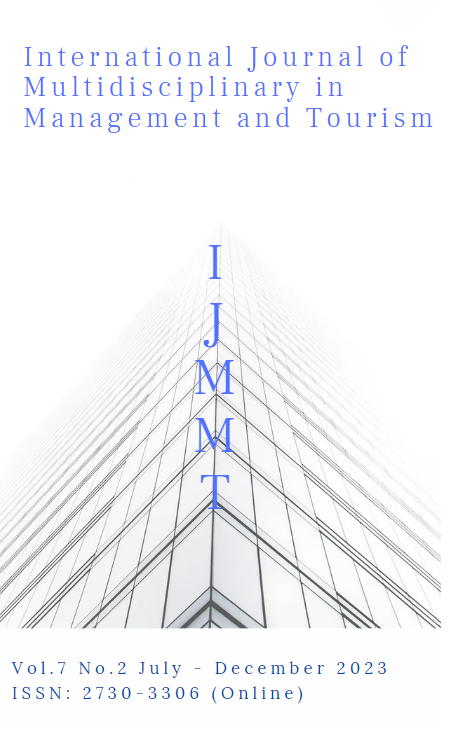The Impact of E-commerce Live Streaming Servicescape on Consumers' Impulsive Purchase Intention
Main Article Content
Abstract
This article aimed 1) to study the impact of e-commerce live streaming servicescape and flow experience effect on consumers' impulse purchase intention, 2) to establish a model of the impact of e-commerce live streaming servicescape on consumers' impulsive purchase intention, and 3) to put forward more targeted and effective e-commerce live streaming marketing suggestions for e-commerce enterprises, consumers and live-streamers. This paper adopts the research methods of quantitative research and qualitative research. In quantitative research, the sample was 402 users with live e-commerce viewing experience or shopping experience. They were selected by a simple method. In qualitative research, the main interviewees are:
2 college students, 2 precious mothers, 2 employees of e-commerce live streaming companies, 2 department directors of e-commerce live streaming companies, and 2 ordinary employees in other industries. The instruments for collecting data were 2 types: questionnaires for quantitative research and in-depth interviews for Qualitative research. Analysis of data by Descriptive statistics and Content Analysis. The research results were found as follows;
1. Social clues include live-streamer credibility, live-streamer interaction, and live-streamer professionalism. It will have a positive and significant effect on consumers' impulsive purchase intention. Physical clues, including atmosphere clues and design clues, will positively affect consumers' impulsive purchase intention.
2. Based on the S-O-R model, the social cues of the servicescape and physical cues of the servicescape are taken as independent variables and flow experience is introduced as the intermediary variable. The model with consumers' impulsive purchase intention as the dependent variable is constructed and tested.
3. As for marketing countermeasures to enhance consumers' impulsive purchase intention in the context of e-commerce live broadcasting, targeted countermeasures, and suggestions are proposed based on e-commerce live broadcasting platforms, e-commerce live broadcasting enterprises, e-commerce live broadcasting live-streamers and consumers who watch e-commerce live broadcasting.
Article Details

This work is licensed under a Creative Commons Attribution-NonCommercial-NoDerivatives 4.0 International License.
References
Baker, J., Grewal, D., & Parasuraman, A. (1994). The influence of store environment on quality inferences and store image. Journal of the Academy of Marketing Science, 22 (4), 328-339. https://doi.org/10.1177/0092070394224002
Chaijaroen, R., & Premthongsuk, P. (2023). The influence of online shopping safety and product quality on the trust and loyalty of online customers. Journal of Educational Management and Research Innovation, 5(2), 291–304. Retrieved from https://so02.tci-thaijo.org/index.php/jemri/article/view/259087
Chang, C. H. & Chen, Y. S. (2012). The Determinants of Green Intellectual Capital. Management Decision, 50(1), 74-94. https://doi.org/10.1108/00251741211194886
Chang, T., Hua, J., Gang, D., & Dan, J. (2018). A brief analysis of the definition, characteristics, development process and business model of network broadcast. Modern Business, 19, 165-168.
Cong F. (2008). Research on the influencing factors of online consumer purchasing behavior based on the perspective of flow experience. Shanghai Jiaotong University.
Csikszentmihalyi, M. (1975). Beyond boredom and anxiety. Jossey-Bass.
Csikszentmihalyi, M. (1990). Flow: The psychology of optimal experience. Harper and Row.
Csikszentmihalyi, M., & LeFevre, J. (1989). Optimal experience in work and leisure. Personality and Social Psychology, 56(5), 815-822. https://doi.org/10.1037/0022-3514.56.5.815
Han Xiao Yi, & Zhengliang, X. (2020). The impact of e-commerce anchor attributes on consumers' online purchase intention: A study based on grounded theory. Foreign Economics and Management, 10, 62-75.
He, C., & Sun, P. (2023). Behavioral effects of performance in distinguishing between work connectivity behavior after-hours: Recognition role to compensation payments of workers fairly. Journal of Multidisciplinary in Humanities and Social Sciences, 6(1), 289–307. Retrieved from https://so04.tci-thaijo.org/index.php/jmhs1_s/article/view/262 135
Hoch, S. J., & Loewenstein, G. F. (1991). Time-inconsistent preferences and consumer self-control. Journal of Consumer Research, 17(4), 492-507. https://doi.org/10.1086/208 573
Hoffman, D. L., & Novak, T. P. (2009). Flow online: Lessons learned and future prospects. Journal of Interactive Marketing, 23(1), 23–34. https://doi.org/10.1016/j.intmar.2008. 10.003
Jianbo, T., Xiaobo, T., & Yiweng, Y. (2018). The mediating effect of shopping website services cape, co-creation value and purchase intention - customer fit. Journal of Finance and Economics, 12, 95-104.
Jiangzhe, W., & Desheng, W., & Ning, S. (2017). The influence of social cues on customer citizenship behavior in network service scenarios: The role of sustained credibility and business friendship. Soft Science, 31(4),112-116.
Ke, W., & Yu, S.-C. (2023). Abusive supervision and employee creativity: the mediating effect of role identification and organizational support. International Journal of Multidisciplinary in Management and Tourism, 7(1), 39–52. https://doi.org/10.14456/ ijmmt.2023.4
Kenny, D., & Marshall, F. (2000). Contextual marketing: The real business of the internet. Harvard Business Review, 11-12, 17-35.
Kotler P. (1973). Atmospheric as a marketing tool. Journal of Retailing, 49(4), 48-64.
Li, M., Ma, Q. H., & Zhao, X. Y. (2014). Research on the effect of network service scenarios on online experience and behavioral intention. Management Science, 27(4), 86-96.
Meizhen, Z. (2019). Research on the effect of service scenario on consumer scene attachment and online behavioral intention: An empirical analysis based on e-commerce live streaming. Wuhan University.
Phattharaphongmanee, D., & Rattamapongpingyo, T. (2023). Brand image building, brand experience and perceived quality by QR code on label of automotive lubricants influencing brand trust and brand loyalty. Journal of Educational Management and Research Innovation, 5(2), 455–470. Retrieved from https://so02.tci-thaijo.org/ index.php/jemri/article/view/260306
Ping, Y. (2018). Service scenario, sensory perception and customer response in mobile Internet environment: Based on case analysis of four enterprises. Collection of Finance and Economics, 5, 76-86.
Sihai, Y. (2016). Research on the influence of virtual environment characteristics of mobile e-commerce on impulsive purchase intention. South China University of Technology.
Yoosuk, S., Shoommuangpak, P., & Pornpundejwittaya, P. (2023). The effect of accountant professional skills on performance in the new normal era. Journal of Multidisciplinary in Humanities and Social Sciences, 6(1), 379–393. Retrieved from https://so04.tci-thaijo.org/index.php/jmhs1_s/article/view/262825
Zhao, A., & Phakdeephirot, N. (2023). Research on influencing factors of employee safety behavior - data from construction enterprises in Hebei province, China. International Journal of Multidisciplinary in Management and Tourism, 7(1), 79–104. https://doi.org/ 10.14456/ijmmt.2023.6

